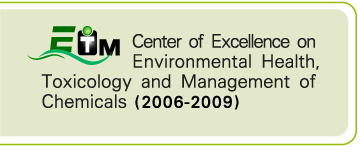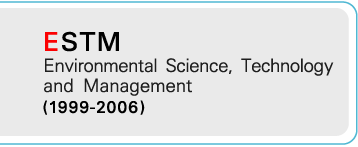| Ecosystems around coastal areas with established petro-chemical industries are likely to be contaminated with petroleum hydrocarbons. From this research of PAHs accumulation and CYP1A biomarker expression in cultured green mussels (Perna viridis L.) at Pradoo Bay, Maptaphut Industrial Estate, Rayong Province in 2011, the level of total PAHs (16 substances) with an average of 0.4303+0.3067 µg/g dry weight and total carcinogenic PAHs (8 substances) with an average of 0.0311+0.0310 µg/g dry weight were found in large sized mussels (6.6186+0.0910 cm mussel length). The level of total PAHs and total carcinogenic PAHs in large sized mussels were higher than medium and small sized mussels, equivalent to 15.36 and 7.49 times for the medium sizes and 14.55 and 10.11 times for the small sizes respectively with statistically significance of p>0.01. There were 9 substances found in PAHs from all sized mussels, which are phenanthrene, fluoranthene, pyrene, chrysene, fluorene, acenaphthylene, anthracene, benz[a]anthracene, and acenaphthene. Two of these substances were carcinogenic PAHs, which are chrysene and benz[a]anthracene. When polyclonal antibody technique was applied in large and medium sized mussels, a 56 kDa CYP1A expression were recorded for all sizes of mussels, which correspond to the level of total PAHs. The result from 2012 reveals the level of total PAHs with an average of 0.4765+0.0615 µg/g dry weight in large sized mussels (6.3940+0.1444 cm). Four substances were found in PAHs which were fluorene, fluranthrene, pyrene, and phenanthrene. However, carcinogenic PAHs were not found in mussels. The ratio of HMW PAHs to LMW PAHs found in mussels in both 2011 and 2012 implies that there was more contamination of pyrogenic PAHs than petrogenic PAHs. Further research were conducted on PAHs effects and depuration on biomarker expression and immunity of commercial sized mussels (P. viridis L.) at Maptaphut Industrial Estate, Rayong Province, and then transferred them to be cultured along the Laemsok coast, Trat Province. In 5 day time, the research found that green mussels were able to dispose of total PAHs, which are flourene, flurantherene, pyrene and phenabthrene from its body thereby reducing the total PAH’s level by half with the volume of 0.2369+0.0311, 0.0985+0.0159, 0.0896+0.0120 and 0.0515+0.0183 µg/g dry weight respectively. In order to dispose total PAHs completely, more than 30 days is needed. The level of PAHs in mussels after 30 days was reduced by 3.13 times. This implies the induction CYP1A protein expression with statistically significant difference (p>0.01). Only at 30 days,the level CYP1A protein induction value (by arbitary unit comparison) in depurated mussels is lower 2 times than mussels raised at Maptaphut with statistically significant difference (p>0.01). The total PAHs with 0.6412 µg/g dry weight (at 30 days) found in mussels raised from Maptaphut.
This research demonstrates that the induction of CYP1A protein in green mussels can be used as a biomarker for monitoring and evaluation of mussels exposed to pollutants in the aquatic environment of Thailand in accordance with analyzing the level of PAHs in animals. Therefore, a continuous monitoring and evaluation of PAHs contamination in aquatic life along the Maptaphut Industrial Estate area is compulsory, because this area has a higher risk of PAHs contamination as well as the possibility to find carcinogenic PAHs in the marine ecosystem. แหล่งข้อมูล:
|
 Center of Excellence on Environmental Health and Toxicology (EHT)
Center of Excellence on Environmental Health and Toxicology (EHT)










